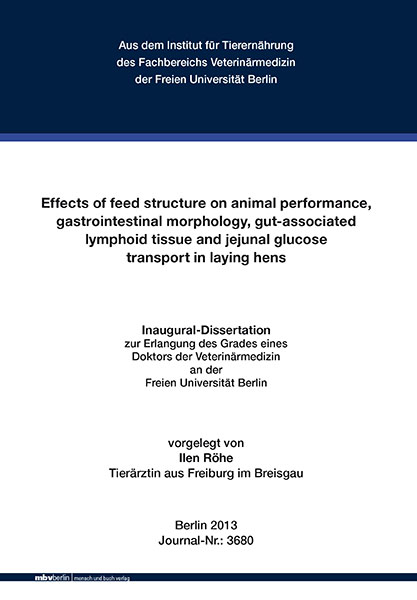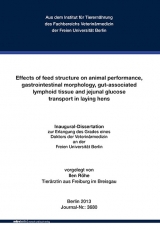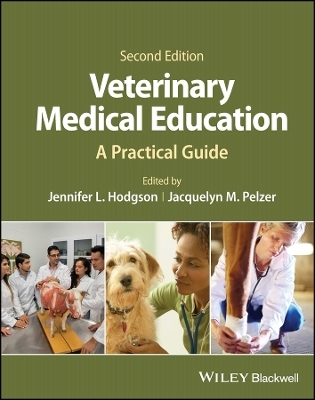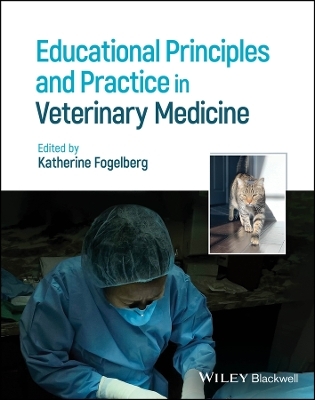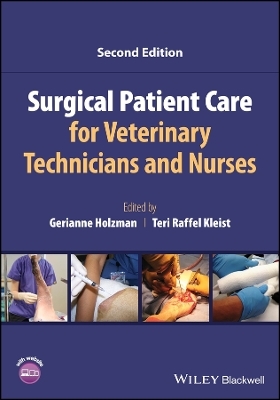Effects of feed structure on animal performance, gastrointestinal morphology, gut-associated lymphoid tissue and jejunal glucose transport in laying hens
Seiten
2014
Mensch & Buch (Verlag)
978-3-86387-441-4 (ISBN)
Mensch & Buch (Verlag)
978-3-86387-441-4 (ISBN)
- Keine Verlagsinformationen verfügbar
- Artikel merken
The world’s population will rise considerably over the coming years and is forecasted to exceed 9 billion people by 2050 (FAO, 2013). This development combined with rising incomes and urbanization will result in a growing demand for livestock products (WHO, 2003). Particularly, the poultry sector is affected by this development, with poultry stocks significantly growing at an average rate of three percent per year (FAO, 2013). Consequently, there is also a growing interest in the opportunities to increase animal health and thus the animal performance. Concerning this matter, the optimization of animal feed and the development of new feeding concepts provide a central starting point. Within the framework of such approaches, the energy consumption used for the feed production is also a factor of interest having an economic and environmental impact.
Therefore, new developments in the production and processing of feed for the use in the poultry sector are promoted in order to increase the quality and safety of feed and to achieve a more energy-efficient feed production. Additionally, innovative resource-conversing feeding concepts are implemented. Hence, different grinding methods, grinding intensities as well as thermal treatment processes are used influencing the structure of feed, which is characterized by the particle size and the particle size distribution as well as by the physical form of the diet. The production of coarsely ground instead of finely ground diets using energy-saving milling methods could reduce the feed production costs and improve the stability, the mixing characteristics and the storability of feed. The further thermal treatment of feed (conditioning) is an energy-intensive process but aims to increase i.a. the nutritive value and thus the digestibility of feed.
As the feed structure is changing by production and processing the question arises whether the animal health and thus the animal performance is influenced by this factor. In contrast to what has been premised so far, recent studies showed that the use of coarsely ground feed and the inclusion of whole grains had no negative impact on the performance of broilers and turkeys, and that in contrast, positive effects regarding the gastrointestinal function and health have been observed (Gabriel et al., 2007; Bank, 2010; Witte, 2012). There is clear evidence that the particle size and the physical form of the diet have an impact on the development of the avian digestive tract, which is also accompanied by changes in physiological processes. Several studies showed that the feeding of coarsely ground as well as mash diets led to an increase of the relative gizzard weights in broilers compared to the feeding of finer particles and thermal processed diets (Nir et al., 1994a; Nir et al., 1994b; Engberg et al., 2002; Peron et al., 2005; Amerah et al., 2007a).
Furthermore, decreased colonization and growth of Salmonella in the caecum was observed when broilers were fed with coarsely ground as well as mash diets (Huang et al., 2006; Santos et al., 2008). Thus, feed structure seems to affect the intestinal microbiota, which could help to prevent bacterial infection and reduce the use of antibiotics in the poultry sector.
Moreover, providing laying hens with structural material, such as coarsely ground feed and foraging material, led to a lower incidence of feather pecking and thereby improved animal health and welfare (Blokhuis, 1986; Aerni et al., 2000; El-Lethey et al., 2000; Hetland et al., 2003b) However, data on the effect of different feed structures on laying hens are limited, whereas these studies generally report performance data (Wahlström et al., 1999; Hetland et al., 2003a; MacIsaac and Anderson, 2007; Safaa et al., 2009).
Therefore, the aim of this study was to investigate whether gastrointestinal function of laying hens and consequently their performance and health were affected by the feeding of differently structured diets. For this purpose, investigations were focused on the influence of feed structure on the development of digestive organs including morphometric examinations, on the gut-associated lymphoid tissue as well as on the jejunal glucose transport in laying hens.
Therefore, new developments in the production and processing of feed for the use in the poultry sector are promoted in order to increase the quality and safety of feed and to achieve a more energy-efficient feed production. Additionally, innovative resource-conversing feeding concepts are implemented. Hence, different grinding methods, grinding intensities as well as thermal treatment processes are used influencing the structure of feed, which is characterized by the particle size and the particle size distribution as well as by the physical form of the diet. The production of coarsely ground instead of finely ground diets using energy-saving milling methods could reduce the feed production costs and improve the stability, the mixing characteristics and the storability of feed. The further thermal treatment of feed (conditioning) is an energy-intensive process but aims to increase i.a. the nutritive value and thus the digestibility of feed.
As the feed structure is changing by production and processing the question arises whether the animal health and thus the animal performance is influenced by this factor. In contrast to what has been premised so far, recent studies showed that the use of coarsely ground feed and the inclusion of whole grains had no negative impact on the performance of broilers and turkeys, and that in contrast, positive effects regarding the gastrointestinal function and health have been observed (Gabriel et al., 2007; Bank, 2010; Witte, 2012). There is clear evidence that the particle size and the physical form of the diet have an impact on the development of the avian digestive tract, which is also accompanied by changes in physiological processes. Several studies showed that the feeding of coarsely ground as well as mash diets led to an increase of the relative gizzard weights in broilers compared to the feeding of finer particles and thermal processed diets (Nir et al., 1994a; Nir et al., 1994b; Engberg et al., 2002; Peron et al., 2005; Amerah et al., 2007a).
Furthermore, decreased colonization and growth of Salmonella in the caecum was observed when broilers were fed with coarsely ground as well as mash diets (Huang et al., 2006; Santos et al., 2008). Thus, feed structure seems to affect the intestinal microbiota, which could help to prevent bacterial infection and reduce the use of antibiotics in the poultry sector.
Moreover, providing laying hens with structural material, such as coarsely ground feed and foraging material, led to a lower incidence of feather pecking and thereby improved animal health and welfare (Blokhuis, 1986; Aerni et al., 2000; El-Lethey et al., 2000; Hetland et al., 2003b) However, data on the effect of different feed structures on laying hens are limited, whereas these studies generally report performance data (Wahlström et al., 1999; Hetland et al., 2003a; MacIsaac and Anderson, 2007; Safaa et al., 2009).
Therefore, the aim of this study was to investigate whether gastrointestinal function of laying hens and consequently their performance and health were affected by the feeding of differently structured diets. For this purpose, investigations were focused on the influence of feed structure on the development of digestive organs including morphometric examinations, on the gut-associated lymphoid tissue as well as on the jejunal glucose transport in laying hens.
| Sprache | deutsch |
|---|---|
| Einbandart | Paperback |
| Themenwelt | Veterinärmedizin |
| ISBN-10 | 3-86387-441-2 / 3863874412 |
| ISBN-13 | 978-3-86387-441-4 / 9783863874414 |
| Zustand | Neuware |
| Informationen gemäß Produktsicherheitsverordnung (GPSR) | |
| Haben Sie eine Frage zum Produkt? |
Mehr entdecken
aus dem Bereich
aus dem Bereich
A Practical Guide
Buch | Hardcover (2024)
Wiley-Blackwell (Verlag)
145,95 €
Buch | Hardcover (2024)
Wiley-Blackwell (Verlag)
124,55 €
Buch | Softcover (2024)
Wiley-Blackwell (Verlag)
95,12 €
